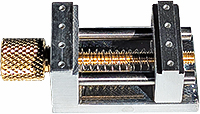
Technical Information Note
Removing Cured Epoxy
Introduction
Epoxies have a wide range of applications in microscopy sample preparation and vacuum chamber feedthroughs or leak repairs. One of the advantages of cured epoxy is that it provides a permanent and strong bond in embedding and adhesive applications. However, the strong bond acts a restriction when it is needed to remove a sample from a cured epoxy embedding or when a sample or part needs to be de-bonded.
Solutions for Removing Cured Epoxies
Techniques for removing spilled epoxy, a sample from an epoxy embedding or an epoxy bond are given below. Please be aware that some of the techniques listed are destructive and can ruin the part or sample. Use safe working practices when removing epoxy. One should always check if the sample is compatible with the technique used. To remove cured epoxies use:
- Solvents
- Sulfuric acid
- Thermal decomposition
- Thermal shock
- Combination of heat and pressure
- Boiling water
- Solvents Chlorinated solvent aggressively attacks cured epoxy. Methylene chloride (dichloromethane) has been used successfully after soaking the material for several hours. Methylene chloride is one of the main components of commercially available epoxy removers. Other solvents which have shown to be effective are: toluene, MEK (methyl-ethyl-ketone) and NMP (n-methyl-pyrollidone)
- Sulfuric Acid A warm solution of sulfuric acid dissolves cured epoxy after soaking. For small amounts of epoxy, repeatedly dropping sulfuric acid on the epoxy is a useful technique and doesn’t require soaking.
- Thermal Decomposition Most epoxies will decompose and turn to carbon ash at temperatures above the degradation temperature. The degradation temperature should be listed on the data sheet of the epoxy. It is likely to be 400°C and higher
- Thermal Shock When substrate, epoxy and parts have large differences in thermal expansion rates, large temperature differences would stress the epoxy and can cause cracks in a bond line. It might be needed to subject the parts to a multiple temperature cycles. Quick changes in temperature would cause maximum stress.
- Combination of Heat and Pressure Epoxies are thermosetting resins which have a glass transition temperature (Tg). Heating above the Tg will soften the cured epoxy and allows de-bonding. When the adhesives become soft, it can be pried away more easily. Heating can be done with a soldering iron, hotplate or an oven..
- Boiling Water When epoxies are exposed to boiling for a longer period of time, the epoxies will lift away from most surfaces. Some mechanical action might be needed. This technique is suitable for embedding samples combined with thermal shock to crack the epoxy as long as the sample is compatible with the techniques used.
Note 1: When larger amounts of epoxy need to be removed, consider mechanical methods (cutting) before resorting to the techniques listed above.
Note 2: If epoxy used to bond a sample to a substrate for specimen preparation and the sample needs to be removed, consider using cyanoacrylate (superglue). Cyanoacrylate can be easily destroyed with a cyanoacrylate de-bonder.




